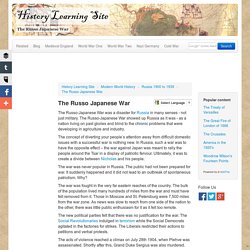

Evaluative Language. McKean Between the Revolutions 1905 1917. The Russo Japanese War. The Russo-Japanese War was a disaster for Russia in many senses - not just military.

The Russo-Japanese War showed up Russia as it was - as a nation living on past glories and blind to the chronic problems that were developing in agriculture and industry. The concept of diverting your people’s attention away from difficult domestic issues with a successful war is nothing new. In Russia, such a war was to have the opposite effect – the war against Japan was meant to rally the people around the Tsar in a display of patriotic fervour. Ultimately, it was to create a divide between Nicholas and his people. Russian Revolution in Color. World War I: Russian Revolution 1/4. World War I: Russian Revolution 2/4. World War I: Russian Revolution 3/4. World War I: Russian Revolution 4/4. Www.orlandofiges.info. Russian Revolution historiography. The webserver at Alpha History tells us you’re using an adblocking tool, plug-in or browser extension on your computer or network.

We understand that many people don’t like web-based advertising. Ads on websites can often be irrelevant, distracting and ‘in your face’. Without ads, however, our website would not exist – or it would not be free. Ads are how we fund the creation and delivery of our content. We love providing free textbook-quality content and resources to people like you. If you would like to use our website and its resources, please disable your adblocker or whitelist our website. To access the Alpha History website, please complete one of the following steps: * Disable or deactivate your adblocking software, tool or plug-in. * Whitelist our top level domain (alphahistory.com) in your adblocking software. Thank you for your understanding. Have a nice day! Alpha History staff. Russian Chronology, 1904-1914. Introduction, Contents, a Note on Dates, and Sources “All Russia is one vast madhouse...” - Count Witte, 1906 Before 1905, Russia was an autocracy with no limitations on the authority of the Czar.

But the Czarist establishment was oppressive, inept, and inadequate - especially under a feeble ruler like Nicholas II - and the allegiance of the Russian people had been quietly eroding for years. Disaffection had long been widespread among intellectuals, some of whom had become revolutionaries, but urban workers, peasants, and ethnic minorities all had their own serious grievances. In 1904, Russia blundered into a war with Japan and suffered a series of humiliating defeats.
Last of the Czars - 01 - Nicky and Alix (1996) Last of the Czars - 02 - The Shadow of Rasputin (1996) Last of the Czars - 03 - Death of the Dynasty (1996) The 1905 Russian Revolution. Crisis & Revolution in Russia (1905) 1905 Russian Revolution. At the beginning of the 20th century the Russian industrial employee worked on average an 11 hour day (10 hours on Saturday).

Conditions in the factories were extremely harsh and little concern was shown for the workers' health and safety. Attempts by workers to form trade unions were resisted by the factory owners and in 1903, a priest, Father Georgi Gapon, formed the Assembly of Russian Workers. Within a year it had over 9,000 members. 1904 was a particularly bad year for Russian workers.
Prices of essential goods rose so quickly that real wages declined by 20 per cent. In an attempt to settle the dispute, Georgi Gapon decided to make a personal appeal to Nicholas II. When the procession of workers reached the Winter Palace in St Petersburg it was attacked by the police and the Cossacks. In June, 1905, sailors on the Potemkin battleship, protested against the serving of rotten meat. Sergi Witte, the new Chief Minister, advised Nicholas II to make concessions. Russian Revolution of 1905. Timeline of the Russian Revolution of 1905. January • January 3-8: 120,000 workers strike in St.

Petersburg; government warns against any organised marches. • January 9: Bloody Sunday. 150,000 striking workers and their families march through St. Petersburg to deliver a protest to the Tsar, but are shot and ridden down on multiple occasions by the army. • January: Reaction to the massacre spreads across neighbouring regions, especially the industrial centers which experience spontaneous workers' strikes. February • February: The strike movement spreads down to the Caucasus. • February 4: Grand-Duke Sergei Alexandrovich is killed by an SR assassin as protests grow.
March • March: The strike movement and unrest reaches Siberia and the Urals. April • April 2: The second National Congress of Zemstovs again demands a constitutional assembly; the Union of Unions formed. May • May: Embarrassment for the government as the Baltic Fleet is easily sunk, having spent 7 months sailing round to Japan. Marxist interpretation of 1905.